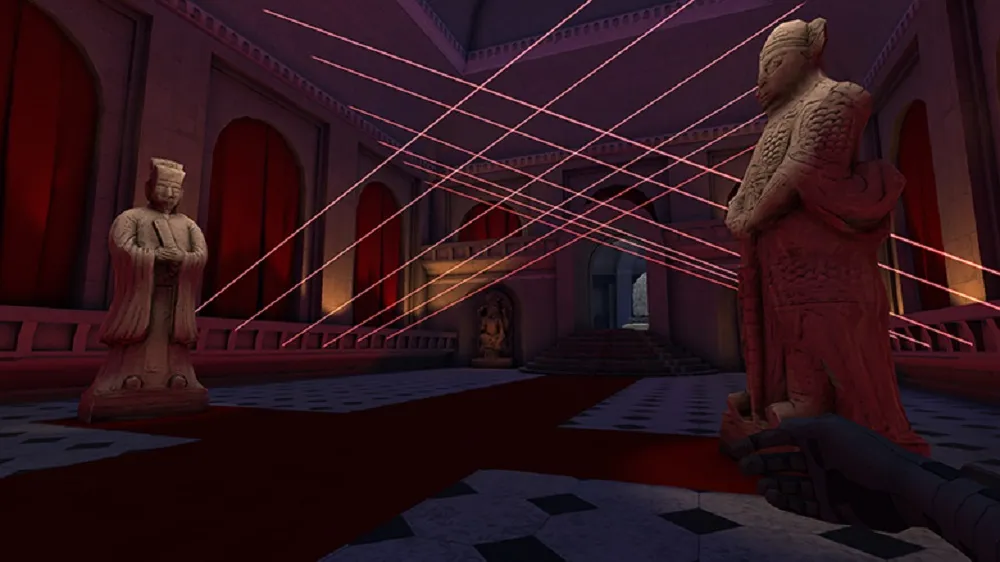We all know how heist movies go. A sassy squad of thieves is about to finish the perfect job when, surprise, surprise, someone betrays them. It might be a friend looking to scoop the whole score or an undercover police officer determined to make his name. In the case of Covert, though, it’s Oculus’ own hardware that’ll land you behind bars.
Covert is, in many ways, an excellent VR game. It requires two players; one inside the Oculus Go headset sneaking through museums and corporate headquarters, whilst the other is on a mobile device, pointing out guard patrol routes, opening doors and solving puzzles in tandem. It’s like Keep Talking And Nobody Explodes stretched into a full campaign with hours worth of play. When it works, it offers some of the best VR co-op since that game, but Covert’s ambition is often outstripped by the limits of the hardware it’s debuting on.
Sneaking past guards and spotlights, for example, is frustrated by Go’s touchpad which provides sluggish smooth locomotion. It just doesn’t give you the tight response needed to make a last minute sprint across a hallway and was often the cause of many an irksome death. In developer White Elk’s brilliant last game, Eclipse, the pacing encouraged exploration so this wasn’t an issue, but Covert is a much more demanding experience and the controls just can’t keep up.
The same is true in tricky, time-sensitive moments and puzzles. You’ll often need to latch a hook shot onto a steel beam to hoist yourself over a gap, for example, but I’d usually struggle to find the spot I needed to stand in to get the icon to appear and would be shot whilst I was fighting with Go’s 3DOF motion controller. The motion device is represented as a hand in-game, making it more of a cruel teaser that you don’t have a full range of movement to help you in tight spots.
I mean, this is a VR stealth game in which you can’t lean around corners to spot guards, which is one of the most satisfying aspects of other entries in the genre. That speaks for itself.
It is possible to go through stretches of the game where you won’t encounter these issues during which Covert does feel like a worthy follow-up to Eclipse. There are some absolutely brilliant ideas here, like getting mobile users to direct players across safe passages on an electrified floor, or having them operate a crate that can block out laser grids and even taxi them over other threats.
In it’s best moments its fuses its individual mechanics together naturally, like one sequence in which the VR player must weave in and out of office buildings, scanning objects in an attempt to find a keycard that will get them through a certain door. The mobile player needs to stay in constant contact about enemy locations and has to be quick with their fingers to create distractions. It is absolutely thrilling and a great example of what’s possible when Go doesn’t get in the way.
Even the story puts in an appreciated, if perhaps unnecessary, effort, having you join a league of thieves and freeing one of its key members before moving on to bigger threats. It does at least give context to the wide variety of environments you’ll explore, which are visually among the sharpest worlds you’ll find in Go.
Not all of the game’s faults lie with the hardware itself, though. Covert is a largely linear game, both in environment and player agency, and I found it quickly fell to pieces if I tried to do anything it didn’t anticipate. At one point, for example, I slipped past some guards raining down machine gun fire on me and retreated back into an area I’d already been in. Rather than finding cover behind the walls, though, bullets seemed to simply pass through them as if the game had forgotten they existed. In another instance, I just fell through the floor altogether and floated down into a black abyss.
Some of its puzzles also infuriate far more than they do entertain, like one recurring challenge in which the mobile user needs to drag a disc around the screen, avoiding incoming obstacles whilst the VR user must scan it without touching them either. On mobile, your finger gets in the way of the view, making it difficult to anticipate every move (though you can, through repetition, learn the patterns) and it’s too fast-paced to communicate to the VR user where you’re moving. It’s a nice idea but it ends up being more of a roadblock than a fun challenge, as do a handful of other difficult spikes.
Normally I’d try and separate a game I’m reviewing from the piece of hardware it’s running on, but Oculus Go is a weight around Covert’s neck. Sluggish controls and limited tracking keep the game from the stealthy slickness its otherwise excellent ideas and execution deserve. I suspect we might see Covert arrive on other, more capable Oculus headsets in the future and, when it does, it’ll easily be an instant recommendation. For now, though, this is only for Go owners that are starved of richer content.
Covert is available now on Oculus Go for $9.99. Read our Game Review Guidelines for more information on how we arrived at this score.




























